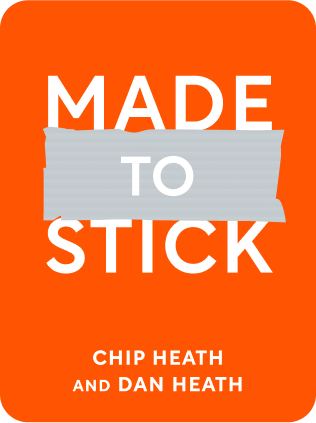

This article is an excerpt from the Shortform book guide to "Made to Stick" by Chip Heath and Dan Heath. Shortform has the world's best summaries and analyses of books you should be reading.
Like this article? Sign up for a free trial here .
Why is credibility important in communication? How can you build credibility?
Credible communication sticks with people. When people trust you, they believe what you have to say. The Heath brothers share ways you can build credibility to help make your message stick.
Continue reading to learn about the power of credible communication.
Credible Communication Is Sticky
The second “C” in the SUCCESs formula for creating “sticky” messages stands for “credible.” Besides being easy to grasp, your message has to be believable. People’s beliefs are shaped by social influences, such as family, friends, and faith, as well as personal experience. Countering people’s beliefs or getting them to believe a new message seems like a daunting task at first glance. Yet urban legends and false stories stick and spread easily.
The reason is that in addition to being easy to understand, they use authority to build credibility. The simplest way to exercise credible communication is to be an authoritative source or to quote one. Well-known experts such as the Surgeon General (for health messages), Alan Greenspan (economics), or Bill Nye (science) lend weight to messages in those fields. Another type of authority is the celebrity who endorses products—celebrities have credibility with people who aspire to be like them.
Here are two messages with seemingly authoritative sources but different outcomes:
- In 1999, people started receiving and sharing an email message warning that bananas from Costa Rica were contaminated with a flesh-eating bacteria. The message, originating with the “Manheim Research Institute,” warned people not to buy the bananas for three weeks and, if they got a rash, to seek immediate treatment. The bacteria allegedly could consume two to three centimeters of skin per hour. The Food and Drug Administration supposedly knew about it but didn’t warn people in order to preclude mass panic. Subsequent versions of the message claimed the problem had also been verified by the Centers for Disease Control. Citing the bogus Manheim institute, FDA, and CDC helped make the message stick.
- Up until the 1980s, medical authorities believed ulcers were caused by too much stomach acid from spicy foods, stress, and alcohol. There was no cure, just treatment of the painful symptoms. However, in the early 1980s, two Australian medical researchers discovered a correlation between ulcers and a specific bacteria. This meant ulcers could be quickly cured with an antibiotic. While the story would seem authoritative to a layperson, the medical establishment didn’t believe it—it went against conventional wisdom and the researchers were young and little-known—and it took years for the establishment to accept the new finding.
The examples show that the amount and type of authority required for credible communication depends on the audience. Average people believed a bogus source in the banana scare example, but doctors doubted medical colleagues whose ulcer research challenged current thinking.
Fortunately, however, the ulcer research story didn’t end there. One of the researchers, Barry Marshall, got frustrated with the disbelief and added a layer of authority to the message that was harder to dismiss.
One morning, with colleagues as witnesses, he chugged a glass of water containing about a billion ulcer-causing bacteria. When he got extremely sick a few days later, tests showed his stomach lining was inflamed, which is the early stage for developing an ulcer. Then, he cured himself with an antibiotic. His demonstration prompted other researchers to build evidence supporting his ulcer finding, although it took ten more years for the National Institutes of Health to back antibiotics as a treatment for ulcers. Finally, ten years after that, Marshall and his colleague, Robin Warren, received a Nobel Prize.
Marshall’s message finally became credible when other researchers, prompted by his vivid demonstration, added authority by confirming his findings.
External Credibility
Using experts and celebrities as authorities builds external credibility for a message. Alternatively, you can buttress your message by using someone who’s an authority by virtue of personal experience.
In the 1990s, Pam Laffin, a 29-year-old mother who suffered devastating effects from smoking, was a compelling messenger for a series of anti-smoking ads. She had started smoking at age 10 and had emphysema by 24. A lung transplant attempt failed. A series of public service ads showed spots on her lungs and surgical scars on her back and showed her struggling to breathe. She died two years later. She was able to use credible communication—sending a powerful and authoritative message—because of her direct experience.
For some messages, the trustworthiness of a source rather than their status or expertise can make them an authority worth listening to. For instance, you may not believe a commercial that extols the benefits of a shampoo, but if a friend starts raving about it, you’re likely to give it a try.
Internal Credibility
If you don’t have access to an authority who can give your message external credibility, you can build internal credibility in four ways.
1) Use Details
Credible communication includes concrete, vivid details. For instance, if you’re a Civil War enthusiast and you tell an interesting Civil War story, your knowledge of the details will build credibility for you and at the same time, the details will make the story itself credible. Similarly, urban legends, particularly horror stories, seem credible when localized details, such as street names and familiar landmarks, are used.
One research study showed that details can lend credibility even if they’re irrelevant to the message. In a simulated exercise in which “jurors” were tasked with deciding whether a mother should retain custody of her son, the jurors were more likely to believe she was a good mother when given additional, vivid details like the fact that her son had a Darth Vader toothbrush. Even though the detail was irrelevant in a legal sense, it served a purpose: it allowed the jurors to picture the child using the toothbrush, which gave credibility to the argument that the woman was a good mother because she made sure her son brushed his teeth.
2) Use Data, but Make it Understandable
Credible communication sometimes involves statistics. Using statistics can help build internal credibility for a message, as long as they’re presented in an accessible way. For example, in the 1980s, an anti-nuclear weapons group struggled to make audiences understand the scale of the world’s nuclear arsenal of 5,000 warheads. The number by itself didn’t mean anything, so they created a simple demonstration comparing the capability of one Hiroshima bomb to the capability of the current arsenal. To represent the Hiroshima bomb, a speaker for the group would drop a single BB into a metal bucket. Then he dropped ten BBs into the bucket to represent the capacity of one nuclear-armed submarine—this made a lot more noise than one BB did. Finally, to represent the world’s nuclear capacity, he dumped 5,000 BBs into the bucket. The reverberating roar made the number tangible and credible.
The BB example makes another key point: the way to make statistics meaningful is to show a relationship. The statistic of 37 grams of fat in a bag of movie popcorn became meaningful when it was related to the amount in a full day of high-fat meals.
Another way to make statistics accessible is to put them in the context of human experience—for instance, introducing a scientific concept this way: “Imagine throwing a rock from Los Angeles to New York…”
3) Use a Compelling Example that Clinches Your Argument
Credible communication is sometimes aided by powerful examples. Frank Sinatra famously sang about New York, “If you can make it there, you can make it anywhere.” The message is that one big success (the ultimate) means you can’t miss—it gives you credibility. Similarly, one standout example can be your ultimate credential. For instance, if your company provided security for Fort Knox, that fact alone would say more about the value of your security services than any numbers you could quote.
4) Make Your Message Self-Testable
Giving your audience a way to test the truth of your message themselves can give it unimpeachable credibility—your audience becomes your authority.
For instance, Wendy’s famous “Where’s the beef?” ad of the 1980s implicitly challenged customers to prove for themselves that Wendy’s burgers had substantially more beef than competitors’ burgers offered. The humorous ad showed a group of elderly fast-food customers staring at a small beef patty dwarfed by a huge bun. One customer asked repeatedly, “Where’s the beef?”—which suggested that other fast-food customers might want to see for themselves how Wendy’s burgers outdistanced the competition.
One persistent urban legend connecting Snapple fruit drinks to the KKK has succeeded in part because it has a self-testing mechanism. As verifiable evidence, the story pointed to two graphics on the Snapple label, a “slave ship” and a logo with the initial K. In fact, the ship on the label derived from an engraving of the Boston Tea Party, and the K logo was a kosher symbol. But for gullible people, just seeing the symbols on the label for themselves was verification enough.
Testable credentials can lead to credible communication beyond the advertising realm. For instance, The NBA used this method during rookie orientation to make its message about the threat of AIDS credible. All rookies were required to attend a week-long orientation at a hotel in New York. The first evening before training, many of them flirted at the hotel bar with a group of female fans. At a group orientation session the next morning, the rookies were surprised when the same women introduced themselves this way, “I’m Brandy and I’m HIV positive.” Rather than hearing a lecture against risky sexual behavior, the rookies learned for themselves to be wary.
As the examples illustrate, there are many ways to create credible communication. You can use multiple methods or, if one doesn’t work, add another, as ulcer researcher Barry Marshall did.

———End of Preview———
Like what you just read? Read the rest of the world's best book summary and analysis of Chip Heath and Dan Heath's "Made to Stick" at Shortform .
Here's what you'll find in our full Made to Stick summary :
- What makes some messages “stick” while others go unremembered
- The six criteria for shaping your message so it resonates
- Why many companies are blinded by “the curse of knowledge”






